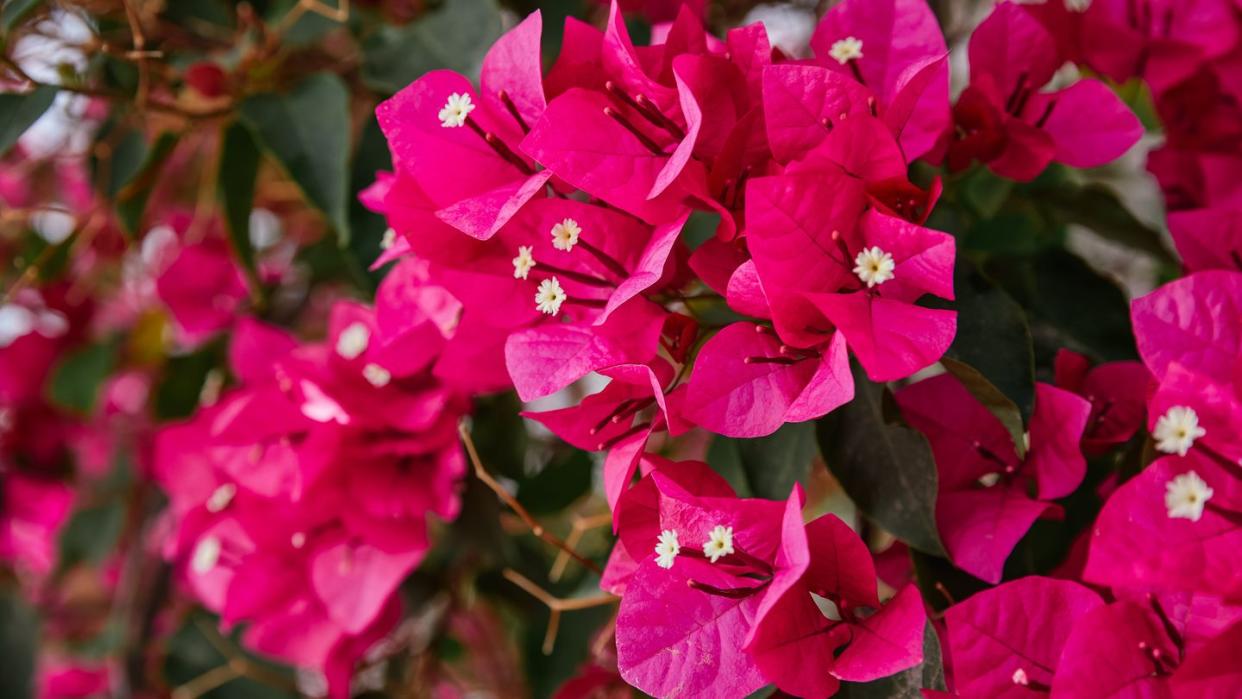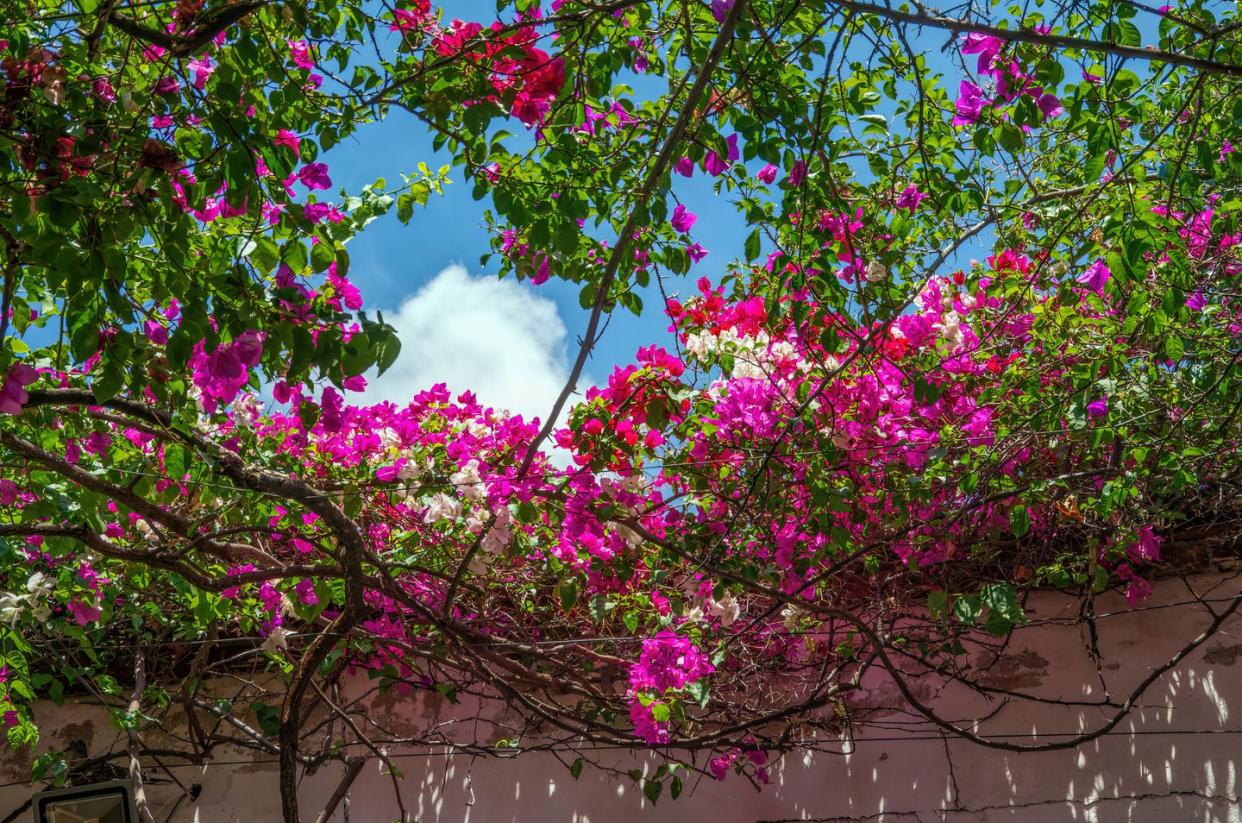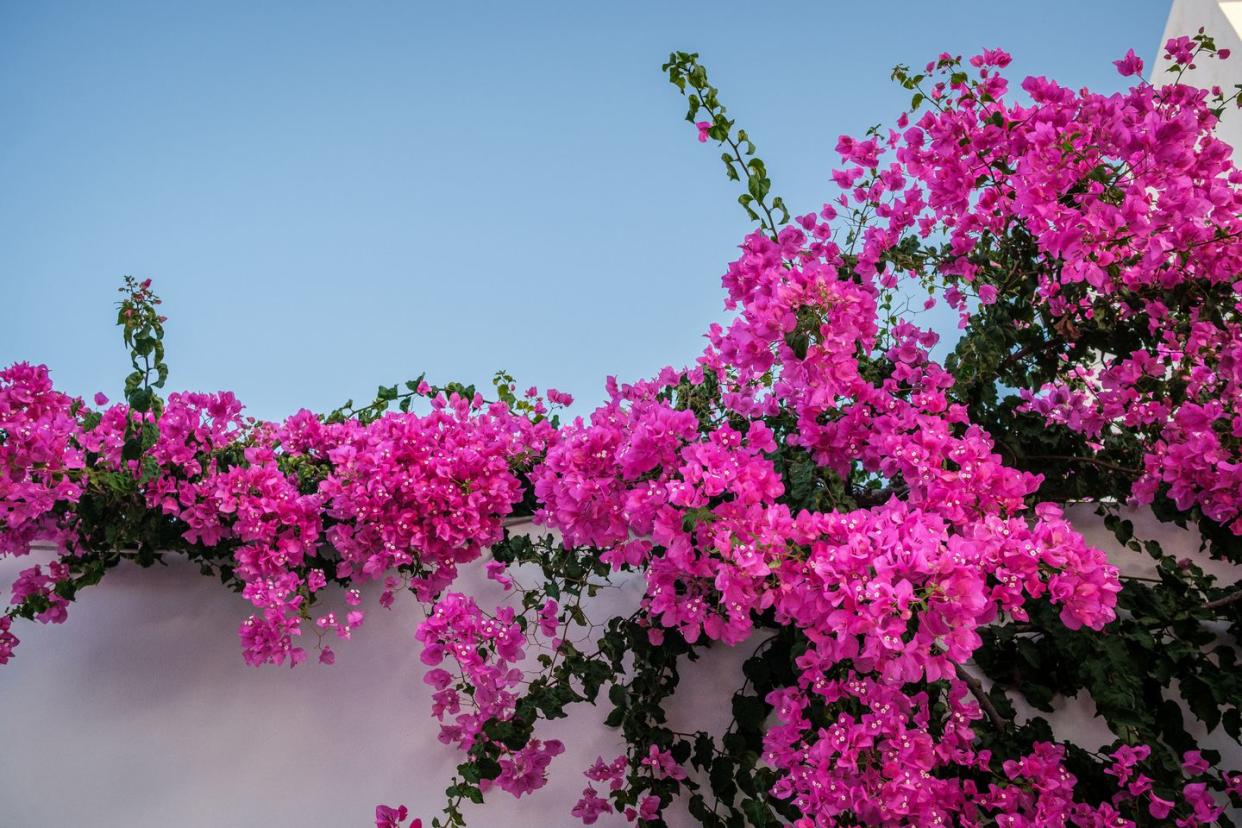How to Grow Bougainvillea for a Backyard That's Simply Stunning

"Hearst Magazines and Yahoo may earn commission or revenue on some items through these links."
If you want your backyard space to look like something out of a postcard, we've got the perfect plant for you: Bougainvillea is a dazzling tropical vine that comes in gorgeous colors like neon pink, peach, red, and white. The unusual blooms consist of tiny white or cream-colored flowers surrounded by brilliantly hued papery bracts or modified leaves.
This South American native is as tough as it comes. Bougainvillea doesn't mind poor soil, heat, or drought once it's established. It's an evergreen perennial in USDA Hardiness zones 9 to 11 (find your zone here) and looks amazing climbing up a wall or being pruned into more of a shrub or tree form. Many types bloom year-round in frost-free areas.
In colder climates, you can grow this beautiful vine as an annual or houseplant. “Bougainvillea are adaptable to pots,” says Tracy Harrison, nursery production planning manager with Monrovia at the Cairo, Georgia nursery. “Growing it in a pot also can limit its size, which may not be a bad thing if you have a small space.”
Harrison, who also is credited with discovering the burgundy queen bougainvillea, says these plants have a fibrous root system which prefers well-drained soil. So, use any good-quality potting mix in your containers to ensure the best results.
Here's what you need to know about how to take care of a bougainvillea plant to help it thrive.
How to Care for a Bougainvillea Plant
Whether planted in the ground or a container, bougainvillea are not super fussy plants, but they do need certain conditions to thrive:
Sunlight
Bougainvillea requires full sun, which is considered six or more hours of direct sunlight per day. It will not bloom in part shade or shade.
Water
These plants don't like to stay soggy. If yours is planted in the ground, make sure it's a well-draining area. They need to be watered deeply and frequently when first planted, but, once established, bougainvillea plants are drought-tolerant.
Fertilizer
Feed your plant with a balanced slow-release fertilizer. Avoid those that are high in nitrogen, which is the first number in the NPK information on the product, says Harrison. Liquid, water-soluble fertilizer also can be used, but not at every watering.
Some fertilizers are labeled specifically for bougainvillea, which is a good idea if you want to ensure you're using the ideal ratio of nutrients.
Where to Plant Bougainvillea
This handsome vine can be trained to climb trellises or garden arbors, but it can also be used as a ground cover in sunny spots. You can also plant it on fences for a privacy screen.
“If you live in a cold climate, you can grow them in the landscape and treat them as annuals,” says Harrison. Raised beds or slopes are good options for planting locations to ensure proper drainage.

How to Grow Bougainvillea in a Pot
For growing bougainvillea in a pot, make sure the planter has holes for good drainage so the plants don't get waterlogged. A trellis is also a good idea for support. Pay attention to moisture levels, checking the pot daily in hot weather.
“Containers should be allowed to dry down in between waterings, but do not let the soil go completely dry,” says Harrison.
How to Prune a Bougainvillea Plant
They can be pruned anytime during the growing season. Keep in mind the size you want to maintain in the location you've chosen and snip accordingly to shape the plant to size. Bougainvillea can be pruned quite hard and return with vigorous shoots, says Harrison. Remove dead branches and trim the tips to encourage new growth.
It's important to know that some types of bougainvillea have sharp thorns, so wear gloves when handling this plant; its thorns can cause serious damage if you're not protected. There are, however, newer cultivars that are thornless.

Common Disease and Pest Issues
Some insects, such as aphids and mealybugs, can be an issue on new bougainvillea growth. Blast aphids off with a garden hose or use a horticultural oil or insecticidal soap. Mealybugs are easy to spot because they have waxy, white, oval-shaped bodies; the easiest way to handle them is to prune out the affected shoots.
The most common disease bougainvillea can experience is root rot, which is caused by overwatering. Various fungal diseases also may be caused by watering too late in the day so that the foliage stays wet too long. Make sure not to keep the plant soggy and water early in the day to help prevent these issues, says Harrison.
Bougainvillea FAQs
Why Is My Bougainvillea Not Flowering?
“One common reason bougainvillea are not flowering well is that the nitrogen provided is too high,” says Harrison. “They fluctuate between foliage growth and flower and bract production, and they tend not to do both well at the same time.” Cut back on how often you're feeding or consider using a different type of fertilizer next time, such as one formulated specifically for bougainvillea.
Another reason for the lack of flowers is that your plant is overwatered. Let it dry out a bit to push it into flower mode, says Harrison.
Finally, check that your bougainvillea plant is getting sufficient sunlight. Make sure they receive full sun, which is considered six or more hours of direct sunlight per day, says Harrison.
How Do I Winterize Bougainvillea?
If you live in a cold climate, bring your potted bougainvillea into a basement or garage to overwinter it before the first frost occurs. Once indoors, “bougainvillea may defoliate a bit in the absence of more intense light and heat,” says Harrison. “It's also important that they're not overwatered and fertilized at this time.” When springtime temperatures rise into the 60s, you can bring it back outdoors.
For warm climates, you can cover your bougainvillea with a frost cloth if the temperatures are going to dip below freezing. If potted, you can move the plant in and out as temperatures dictate, says Harrison.
Is Bougainvillea Toxic to Pets?
According to Tina Wismer, DVM, senior medical director of the ASPCA's Animal Poison Control Center, bougainvillea is considered not toxic to pets; however, the large thorns can cause injury, so keep animals away from these plants.
Also, remember that any plant can cause gastrointestinal distress if eaten in large enough quantities, so always keep an eye on pets near your garden and houseplants. And if you suspect your pet has ingested any plant, even if you're not entirely sure, contact your vet ASAP. It's always better to be safe than sorry!
Follow House Beautiful on Instagram and TikTok.
You Might Also Like
